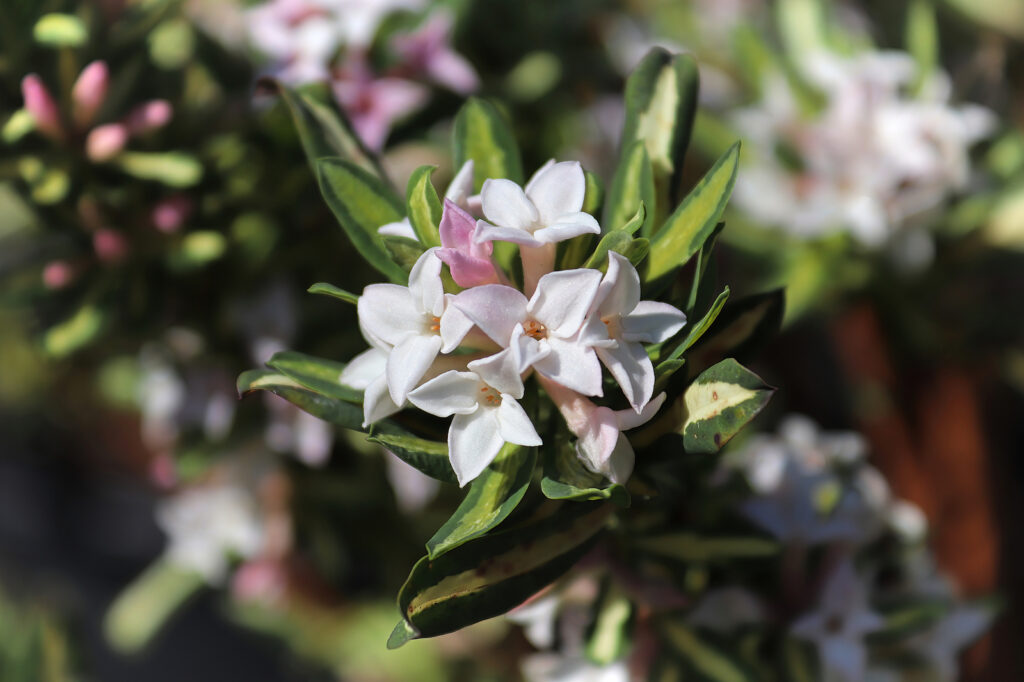分享就是關懷!
達芙妮在早春開出格外芬芳的四瓣管狀花朵。花單生或短簇狀頭狀花序,顏色從紅紫色到粉紅色、淡紫色、淡紫色、黃色和白色。
達芙妮大約有70種。有些是低矮的叢生灌木,有些可以長到 3 到 4 英尺高,有些則可以長到 10 英尺高。大多數都有濃鬱的芳香花朵,應該種植在可以欣賞它們的地方——門口和人行道附近。
兩朵早春盛開的瑞香是 達芙妮不見了 (丁香達芙妮)和 瑞香 或 mezereon(二月達芙妮)。兩者都是落葉植物,可長至約 3 英尺高。紫丁香達芙妮在早春的無葉枝條末端開出半英寸長的簇狀花朵,就像紫丁香一樣。二月達芙妮在溫和的冬季地區於冬末開放,在寒冷的氣候地區於仲春開放。花無莖,沿著樹枝的上部出現。
瑞香最好種植在避開正午陽光的地方。它們在土壤保持涼爽的地方生長得最好。達芙妮的壽命不長;他們有時會無緣無故地陷入衰退。
認識達芙妮
- 植物類型:落葉春季、夏季或秋季開花的灌木
- 種植區與範圍:4-9區
- 堅韌: 堅韌
- 高度和寬度:1 至 4 英尺 (1.2m) 高,3 至 10 英尺 (0.9-3m) 寬
- 葉:窄,帶狀,深綠色,互生
- 花:白色或粉紅色,紅紫色和淡紫色;水果有毒
- 開花時間:春季或初夏;達芙妮有時會在秋天重新綻放
- 用途:基礎灌木或灌木邊界的前面
- 通用名:達芙妮
- 植物學名稱: 芫 種。
- 家庭: 瑞香科
- 產地:歐洲、北非

達芙妮適合種植在哪裡
- 根據品種的不同,將瑞香種植在充足的陽光下或淺色的陰涼處
- 在富含腐植質至中等、排水良好但潮濕的土壤中種植瑞香。
- 達芙妮喜歡中性或微鹼性土壤
達芙妮什麼時候種植
- 在冬末、春季或秋季種植瑞香。
- 在早春或秋季移植容器種植的植物
瑞香的種植和間距
- 根據品種不同,將瑞香間隔 3 至 10 英尺。
如何澆水和餵養達芙妮
- 達芙妮需要適量至充足的水;保持土壤均勻濕潤。如果土壤太濕,達芙妮很容易死。
達芙妮護理
- 在瑞香周圍覆蓋覆蓋物,以保持土壤涼爽並保持土壤濕度。
- 達芙妮除了整形外不需要修剪。
將達芙妮作為室內植物種植
- 達芙妮吩咐道, 冬季達芙妮,可以作為室內植物種植。
- 在濕度適中、光線明亮的溫暖房間裡種植瑞香。
- 兩次澆水之間應讓盆栽介質稍微乾燥。
- 春季用低酸性植物肥料施肥一次。
- 植物開花後,可以剪掉以保留 [p it compact.
Daphne Pests and Diseases
- Daphnes are not long-lived and tend to suffer progressive die-back after a few years.
- Daphne can suffer from viral diseases that cause leaf mottling and grey mold.
Daphne Propagation
- Seeds need cold treatment before sowing.
- Layer daphne branches in fall.
- Take cuttings softwood cuttings in late summer

Daphne Varieties to Grow
- Daphne x burkwoodii, Burkwood Daphne: Semi-evergreen and has a number of variegated cultivars; grows 3 to 4 feet high and wide; small clusters of fragrant flowers that are white then age to pink at branch ends; blooms late spring and late summer in Zones 5-7.
- D. caucasica, Caucasian daphne: Deciduous; grows 4 to 5 feet tall and wide; intensely fragrant white flowers.
- D. cneorum, Garland daphne: Grows 1 foot tall and 3 feet wide; trailing branches with narrow leaves; clusters of fragrant rosy light pink flowers in spring; several cultivars.
- D genkwa, lilac daphne: Grows 3 to 4 feet tall and wide; clusters of lilac-blue, scentless flowers.
- D. mantensiana: Evergreen grows to 18 inches high, spreading to 3 feet; fragrant purple flowers at branch tips; densely branched.
- D. mezereum (mezereon), February daphne: Deciduous, erect growing to 4 feet; fragrant reddish-purple flowers in short clusters; cultivar ‘Alba’ has white flowers.
- D. odora, winter daphne: Very fragrant; has purple-and-white flowers and can grow to 4 feet tall and twice as wide in Zones 7-9; plant where it will get mid-day shade; cultivar ‘Aureo-Marginata’ is hardier and has yellow-edged leaves.
Daphne Frequently Asked Questions
Q: What does daphne need to grow successfully?
A: Daphne likes rich friable (well-worked) soil that is not too acidic. Add aged compost or leaf mold to the soil before planting or as a side dressing at any time. Daphne favors moist but not wet soil. Daphne grows best in full sun but will also grow in partial shade. Mulch the soil to keep it as cool as possible during the summer months.
Q: The leaves of my daphne are turning yellow. Why?
A: Yellowing daphne leaves may be chlorosis, due to alkaline soil which makes iron unavailable. Treat the soil with iron chelates. Another cause of yellowing leaves could be root rot; avoid planting in areas of high moisture content.
Q: How do I propagate daphne?
A: Start new daphne plants from softwood cuttings of young growth in late spring or early summer. Start new plants from semi-hardwood cutting or more mature growth in mid- or late summer. New plants can also be started by ground layering.



